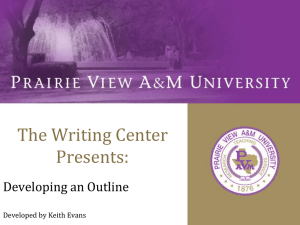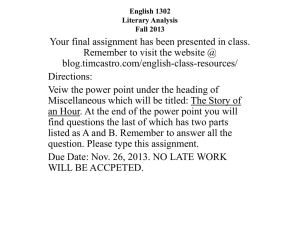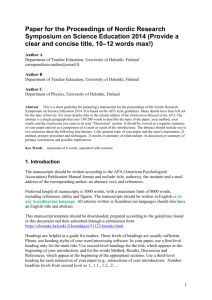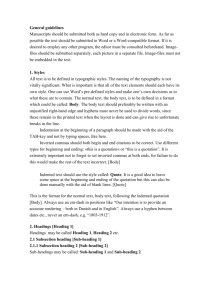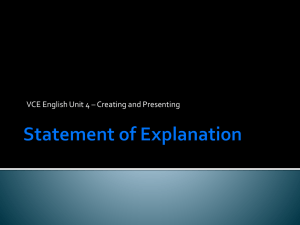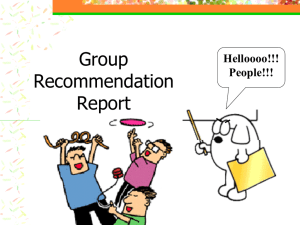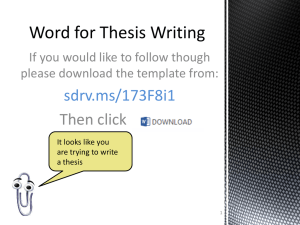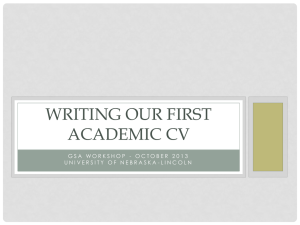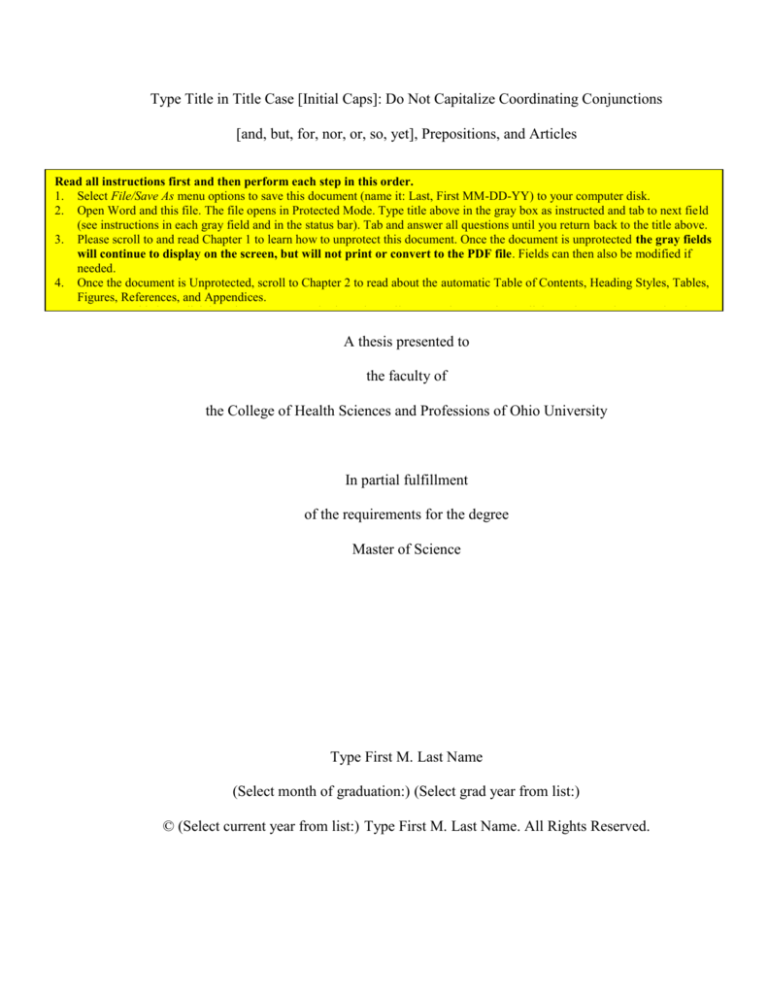
Type Title in Title Case [Initial Caps]: Do Not Capitalize Coordinating Conjunctions
[and, but, for, nor, or, so, yet], Prepositions, and Articles
Read all instructions first and then perform each step in this order.
1. Select File/Save As menu options to save this document (name it: Last, First MM-DD-YY) to your computer disk.
2. Open Word and this file. The file opens in Protected Mode. Type title above in the gray box as instructed and tab to next field
(see instructions in each gray field and in the status bar). Tab and answer all questions until you return back to the title above.
3. Please scroll to and read Chapter 1 to learn how to unprotect this document. Once the document is unprotected the gray fields
will continue to display on the screen, but will not print or convert to the PDF file. Fields can then also be modified if
needed.
4. Once the document is Unprotected, scroll to Chapter 2 to read about the automatic Table of Contents, Heading Styles, Tables,
Figures, References, and Appendices.
5. To remove this box, click it, point to outer gray hash marks until you see the Move icon, click to select, and press Delete key.
A thesis presented to
the faculty of
the College of Health Sciences and Professions of Ohio University
In partial fulfillment
of the requirements for the degree
Master of Science
Type First M. Last Name
(Select month of graduation:) (Select grad year from list:)
© (Select current year from list:) Type First M. Last Name. All Rights Reserved.
2
This thesis titled
Type Title in Title Case [Initial Caps]: Do Not Capitalize Coordinating Conjunctions
[and, but, for, nor, or, so, yet], Prepositions, and Articles
by
TYPE FIRST M. LAST NAME
has been approved for
the (Select School or Department:) of (Select name from list:)
in (Select Program Name from list:), (Select Specialty if Applicable:)
and the College of Health Sciences and Professions by
Type Advisor’s First M. Last name only without degree acronym
Type Advisor’s professional title—use Campus Directory
Randy Leite
Dean, College of Health Sciences and Professions
3
Abstract
TYPE LAST NAME, FIRST M., M.S., (Select grad month from list:)
(Select year from list:), (Select Program Name from list:),
(Select Specialty if Applicable:)
Type Title in Title Case [Initial Caps]: Do Not Capitalize Coordinating Conjunctions
[and, but, for, nor, or, so, yet], Prepositions, and Articles
Director of Thesis: Advisor’s First M. Last name only
An abstract is a concise account of the thesis or dissertation and should state the
problem, describe the procedure or method used, and summarize the conclusions reached.
An abstract is required for all papers. A maximum of 350 words are recommended for
dissertations and a maximum of 150 for theses. Format the paragraphs with the same
layout used in the document. All lines on this page are double spaced.
Text formatting in the document should be uniform in terms of type size, typeface
(font) and line spacing. TAD Services will accept 11 or 12 point text and double spacing
for body text in any standard font (Times New Roman, Courier, Arial, etc.)
4
Preface
Chapter 3 contained within the thesis document serves as a prepublication
manuscript. This manuscript has been formatted to meet the guidelines set forth by
Thesis and Dissertation Services at Ohio University.
5
Dedication
A simple, optional note dedicating the work to a single person or small group of persons.
The dedication is centered, typically in italic and
rarely more than 3-4 lines.
6
Acknowledgments
The Acknowledgments page is optional. This page includes a brief, professional
acknowledgment of the assistance received from individuals, advisor, faculty, and
institution.
7
Table of Contents
Page
Abstract ............................................................................................................................... 3
Preface................................................................................................................................. 4
Dedication ........................................................................................................................... 5
Acknowledgments............................................................................................................... 6
List of Tables ...................................................................................................................... 8
List of Figures ..................................................................................................................... 9
Chapter 1: How to Unprotect this Document ................................................................... 10
Chapter 2: How to Use this Document ............................................................................. 12
What is a run-in heading? ......................................................................................... 12
Making run-in headings work with the automated table of contents. ....................... 13
Chapter 3: Formatting or Modifying Headings in a Manuscript ...................................... 16
What Formats are Included in this Document? ............................................................ 17
Updating the Table of Contents .................................................................................... 17
Removing text from the table of contents that does not belong................................ 18
Tables and Figures ........................................................................................................ 19
Using a table in your document. ............................................................................... 19
Using a figure in your document............................................................................... 20
References ......................................................................................................................... 22
Appendix: How to Format Appendix Pages ..................................................................... 23
8
List of Tables
Page
Table 1: APA 6 Heading Formats by Hierarchy Level...................................................13
Table 2: Electronic Documents Processed in Academic Year 2005-06 .........................20
9
List of Figures
Page
Figure 1. Finding Unprotect Document… This will say Protect Document if the
document is currently unprotected and will say Unprotect Document if the document is
currently locked. ...............................................................................................................9
Figure 2. Formatting a title to Heading 1 level through the Style menu. .......................10
Figure 3. How to modify a heading level .......................................................................14
Figure 4: Electronic theses and dissertations filed by degree 2001-06 ...........................19
*Note to Student: Please note that the capitalization of titles on List of Tables and List of Figures are both
acceptable. For example, Page 6 uses Title Case, while page 7 uses Sentence Case. We only ask that you be
consistent with your choice throughout the document.
10
Chapter 1: How to Unprotect this Document
When you no longer need this document in protected mode, you can remove the
protection.
Under the Tools menu, select “Protect/Unprotect Document…”.
Figure 1. Finding Unprotect Document… This will say Protect Document if the
document is currently unprotected and will say Unprotect Document if the document is
currently locked.
After you click this menu option a password entry box will appear. Enter the
password “etd.” The document protection is now removed. You may now edit this
document. If you already have a thesis or dissertation document, you may want to copy
only parts of this document into your current document. If you choose to paste your text
into this document, you may need to reformat your heading levels before regenerating the
automated Table of Contents. To re-format headings, see Chapter 2.
The document protection is now removed. You may now edit this document. If
you already have a thesis or dissertation document, you may want to copy only parts of
11
this document into your current document. If you choose to paste your text into this
document, you may need to reformat your heading levels before regenerating the
automated Table of Contents. To re-format headings, see Chapter 2.
A video demonstration of unprotecting the document and other common
formatting tips and troubleshooting is available on the TAD web site for both PC and
Mac users:
•
MS Word Training for PC: http://www.ohio.edu/graduate/etd/wordpc.cfm
•
MS Word Training for Mac: http://www.ohio.edu/graduate/etd/wordmac.cfm
12
Chapter 2: How to Use this Document
The first five heading levels in this document have been modified to meet APA
6th edition styles, however the figures show APA 5th edition examples. To format heading
levels, click in each title and select the appropriate heading level (Heading 1 through 5)
while on the Home tab in the Styles group. (Note: The Chapter 2 title above has been
formatted as a Heading 1 level. See Figure 2.) This document provides tips for those
using a PC version of Microsoft Word 2007. For other format tips, also see the Word
2007/PDF Manuals at www.ohio.edu/etd.
Figure 2. Formatting a title to Heading 1 level through the Style menu. (TAD Services
suggests Figure captions be single spaced.)
What is a run-in heading? A run-in heading is when the first sentence of a
paragraph is the section subheading. APA 6 uses this in heading levels 3, 4 and 5. This
type of heading style cannot be applied to the paragraph and appear in the automated
table of contents without a bit of extra work.
13
Table 1
APA 6 Heading Formats by Hierarchy Level
Level Format
1
Centered, Boldface Uppercase and Lowercase Heading
2
Left-aligned, Boldface, Uppercase and Lowercase Heading
3
Indented, boldface, lowercase heading with a period. Begin body text
after the period.
4
Indented, boldface, italicized lowercase heading with a period. Begin
body text after the period.
5
Indented, italicized lowercase heading with a period. Begin body text
after the period.
Making run-in headings work with the automated table of contents. First,
type your heading and the text that follows it as separate paragraphs. I am using APA 6
Heading 3 style in this example:
Heading formatted using Styles palette.
Sample paragraph text lorum ipsum dolor sit amet, etc.
Format the heading using the styles palette and leave the second paragraph alone.
If you don’t have nonprinting characters displayed, press the Show/Hide button
in the Paragraph group on the Home tab of the Ribbon in Word 2007 and 2010 and in
the standard toolbar at the top of Word for Mac. You should see your paragraphs like
this:
Heading formatted using Styles palette.¶
Sample paragraph text lorum ipsum dolor sit amet, etc. ¶
14
Highlight just the paragraph mark (¶) at the end of the heading and format it as
Hidden (Press and hold Control+Shift then type H). You will not immediately see any
change, but when you press the Show/Hide ¶ button again, your paragraphs will join.
When you update your table of contents, only the section styled as Heading 3 should
appear in the listing.
Heading formatted using Styles palette. Sample paragraph text lorum ipsum
dolor sit amet, etc.
15
Some caveats:
•
If your Body Text style is justified (straight with margins on the left and right),
your heading style must also be justified, or else the first line of your paragraph
will not be justified. You can modify this using the information in Chapter 3.
•
You must hide nonprinting characters (or at least Hidden text) before generating
your TOC, or the page numbers will very likely be wrong.
A video demonstration is available:
http://www.ohio.edu/graduate/etd/wordpc.cfm (PC) or
http://www.ohio.edu/graduate/etd/wordmac.cfm (Mac)
16
Chapter 3: Formatting or Modifying Headings in a Manuscript
If you are using this Template document, you should not need to modify heading
styles. If a heading modification is needed: open the Styles task pane by clicking on the
Toolbox Button (see Figure 2). Next, in the Styles task pane click on the desired heading,
then point to the drop down arrow to the right of the heading and click; select Modify
Style… from the menu that appears as shown in Figure 3. The following page discusses
the dialog boxes that follow.
Figure 3. How to modify a heading level.
The dialog box that appears allows you to change the heading level’s font, text
size, line spacing, alignment, boldface, and spacing before and after a heading (click
Format Button/select Paragraph/set Before and After to zero), and more.
17
What Formats are Included in this Document?
Click in the title above, look at the Style box (while on the Home tab in the Styles
group) and note the block “Heading 2” was selected. This document contains most
required formats for an Ohio University thesis or dissertation. The settings include:
global margin and header settings; page breaks; page numbers; automatic “total number
of pages” field on Abstract page (see below); an automatic Table of Contents; the
heading levels adopted by all Ohio University colleges for theses and dissertations; and a
sample table and figures.
If you have elected to use this template to format your document, just delete any
unwanted text and tables/figures from this document after reviewing all instructions and
then copy and paste your chapters in the appropriate place. Remember, you may need to
click in each heading within your document, format them to the appropriate heading
levels as discussed above, and finish by updating the Table of Contents.
Updating the Table of Contents
While you may hand type your Table of Contents, there is an automated Table of
Contents already available in this document. Simply format all heading levels as
discussed, right click in any gray area of the current Table of Contents, and select Update
Table, select Update entire table from the menu, and click OK. Any time a change is
made to a heading or text is modified, the Table of Contents needs to be regenerated
(using the steps just mentioned).
The Table of Contents in this document was generated originally by clicking on
the References tab. In the Table of Contents group, the Table of Contents drop down
18
menu was clicked and the Insert Table of Contents was selected. (The Show Page
Numbers and Right Align Page Numbers were checked and the Tab Leader “….” options
were selected by default.). You should not need to generate a new Table of Contents
using the steps just mentioned unless your Table of Contents code becomes corrupt. For
example, the dot leaders begin to function incorrectly or the case styles of titles do not
appear in the correct format. To recreate the Table of Contents, click in any gray area in
the present Table of Contents and select Index and Tables from the Insert menu, select
Insert Table of Contents. A Table of Contents dialogue box opens, and you may select
from any of the available Formats (Classic, Distinctive, Fancy, Modern, Formal and
Simple) to replace the current Table of Contents format. TAD Services recommends
selecting the Formal style, but any of Microsoft Word’s built-in template styles that
include dot leaders are acceptable formats for the Table of Contents (once a new template
style is selected, there is no need to modify the text style of the template, unless requested
by your Committee).
Removing text from the table of contents that does not belong. Click in the
title above, look at the Style and note the block “Heading 3” was selected. Sometimes
when you update your Table of Contents, extra text appears within the Table of Contents
that should not be there. This occurs with misplaced paragraph codes (obtained by
pressing the Enter key) or heading codes in the document text. Locate and select the text
in the document that should not be in the Table of Contents. Next, select the Normal
block from the Style box and then regenerate the Table of Contents (right click on any
gray area in the Table of Contents and select Update Table). If this does not correct the
19
problem, click your Show/Hide icon located. Move to the area of the document where it
is not coded correctly and use your arrow keys to step through the document. While on
the Home tab in the Styles group, watch for the heading box to be highlighted. Once you
see a heading appear that should not be there, scroll to see where the code begins and
ends. Select the area that is not formatted correctly and select Normal from the Style
menu to reformat this text.
To correct a heading that appears twice in a Table of Contents, simply add a
paragraph code in the document before the heading as follows: move to the heading in
the document and press the Enter key once before the heading at the top of the page. You
can also try to move to the bottom of the page before and pressing the Enter key at the
end of the paragraph to correct this error. (Microsoft Word formats headings between
paragraph marks [created when you press the Enter key], so if a title appears twice in the
Table of Contents, Word is interpreting the title to expand over two pages due to the
placement of the paragraph codes).
Tables and Figures
Using a table in your document. Click in the title above, look at the Style box
and note the block “Heading 3” was selected (if needed, please see figure and instructions
at the beginning of Chapter 3). The Table 1 sample below is formatted in APA style. The
table text is double spaced. The Table # stands alone on a line above the title. The title is
italicized and is in Title Case (Initial Caps). The Enter key should be pressed two times
while in double space mode before and after the table to separate the table from other text
20
in the document. Tables and figures are always mentioned in text before they appear in a
document. APA style requires that all tables and figures be left aligned in a document.
Table 2
Electronic Documents Processed in Academic Year 2005-06
Quarter
No.
%
Fall ’05
45
21
Winter ’06
44
21
Spring ’06
60
28
Summer ’06
62
29
Total ETDs
211
100
Using a figure in your document. Figures are formatted similarly to tables
within a document. Press the Enter key two times in double space mode (leaving three
blank lines) before and after the figure. Figures are mentioned in the text before they
appear in a document. In most APA styles, the caption is placed below the figure in
sentence case (instead of Title Case as seen on Tables) and ends with a period (see Figure
3 caption). Note in APA the word “Figure” and the number are both italicized.
21
Figure 4. Electronic theses and dissertations filed by degree 2001-06.
22
References
Use your departmental style requirement to format your references. References
are checked for completeness and consistency in format by Thesis and Dissertation
Services.
If hanging indents are required by your style handbook (APA, MLA, etc.),
position the cursor in the reference paragraph (or select multiple paragraphs) and on the
Ruler Bar (select View/Ruler
if needed on the right hand side of the screen), drag the
Hanging Indent icon found on the left side of the Ruler Bar to ½ inch (to indent the
second line of text ½ inch from the left margin). See sample hanging indent reference
below
Sample reference with hanging indent:
Denscombe, M. Ground Rules for Good Research. Philadelphia, PA: Open University
Press, 2003.
23
Appendix: How to Format Appendix Pages
The appendix contains pages that do not fit well within the body of your
document or that stop the flow of your document. Appendices typically contain data
tables, letters, consent forms, programming codes, etc. Any style font and text size can be
used in an appendix. The only rules you need to follow are 1) the word “Appendix” and a
title should appear at the top of each appendix, and 2) the margins remain the same as in
the rest of the document. Use the following labels at the top of the first page of each
appendix for multiple appendices: Appendix A: Title, Appendix B: Title, etc. Label each
in the order in which they are mentioned in the main text. Each appendix should appear
in the Table of Contents. TAD Services recommends that the title of each appendix also
appear in the Table of Contents.


